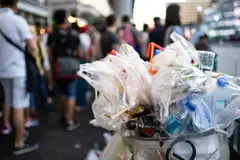US EPR should exclude film packaging, urges Alliance for Mission-based Recycling
Key takeaways
- AMBR reports challenges in recycling film and flexible packaging due to complex materials and limited markets.
- AMBR calls for EPR legislation to exclude film packaging from curbside recycling and prioritize reduce and reuse strategies.
- States like California, Maine, and Oregon are leading in the US with producer responsibility laws.
A recent report by the Alliance for Mission-based Recycling (AMBR) has urged EPR legislation in the US not to include film and flexible packaging in curbside recycling programs.
The report “Designing Effective EPR: What to Do About Film & Flexible Packaging” explains that film and flexible solutions cannot be recycled on a large scale due to complex material composition and limited end markets.
Packaging Insights speaks to Lucy Mullany, national policy director at AMBR, about EPR in the US and the “significant problem” of film and flexible plastic for municipal recycling programs.
Mullany says the US is making real progress toward producer responsibility. States like Maine, Oregon, Colorado, California, Minnesota, Washington, and Maryland have passed EPR laws for packaging and paper.
She explains: “The next step is ensuring these laws are implemented effectively and equitably — resulting in waste reduction, expanded reuse systems, and material redesign.”
Hard to recycle
The AMBR report highlights concern over end markets for film and flexible packaging, stating they can often “stretch the definition” of recycling. Current markets include plastic-to-fuel, road construction, burning in cement kilns, and use in aggregate, filler, or drainage systems.
Mullany adds: “Despite industry claims, there are few viable end markets, meaning most film is downcycled, landfilled, or incinerated — undermining recycling goals and harming our environment.”
Additionally, the report outlines another problem: film and flexible packaging can contaminate paper streams and potentially damage facility operations.
“Flexible plastic films are difficult and costly to collect, sort, and recycle, often contaminating valuable recyclables like paper and clogging recycling equipment,” says Mullany.
Hope for EPR
Mullany states that AMBR wants EPR regulations to exclude flexible films from curbside recycling and prioritize reduce and reuse.
“If a material is actually going to be considered recyclable, it must be collected, sorted, sold to a stable end market, and turned into something new. Flex and film plastics have not been able to meet these requirements — only about 2% of film packaging is recycled nationwide, largely through special drop-off programs, not curbside collection.”
Mullany notes that policymakers recognize that these materials are “inherently problematic” and must be addressed through legislation.
Producer transparency
The report also urges EPR regulation to require detailed producer reporting and ban counting incineration or fuel conversion as recycling. It also advocates for prohibiting plastic recycling credit schemes for recycled content claims.
Mullany concludes: “Effective EPR policies can balance these interests by ensuring producers fund and design for truly recyclable or reusable materials, keeping recycling systems efficient and affordable for communities.
“At the same time, strong standards, transparency, and clear labeling help consumers make responsible choices while maintaining public trust.”











